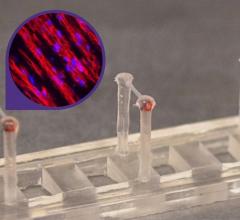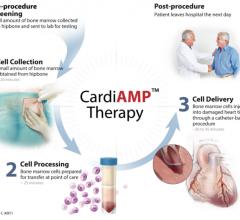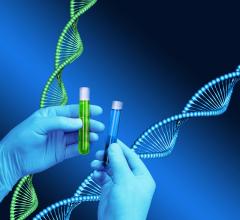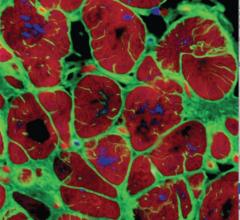
May 5, 2014 — The U.S. Food and Drug Administration (FDA) MSC Consortium is a large team of FDA scientists studying adult mesenchymal stem cells (MSCs), which could eventually be used to repair, replace, restore or regenerate cells in the body, including those needed for heart and bone repair. The FDA said the scientists’ investigational work is unprecedented, with seven labs at FDA's Center for Biologics Evaluation and Research formed the consortium to fill in gaps in knowledge about how stem cells function.
“This research aims to facilitate development of this important class of innovative medical products,” explained Carolyn A. Wilson, Ph.D., associate director for research at the center. “It’s the first time we’ve done anything like this, and it’s proven to be a very useful approach. It’s worked so well because this is a huge, complicated project that requires expertise in many different technologies and methods.”
The research could ultimately be key to the advancement of personalized medicine, the practice in which medical treatment is tailored to the needs of an individual patient. “It’s not science fiction,” said Steven R. Bauer, Ph.D., chief of the Cellular and Tissue Therapy Branch in FDA’s Office of Cellular Tissue and Gene Therapies. “For me, regenerative medicine is the most exciting part of what we regulate in our office.”
Stem Cells Basics
There are two basic kinds of stem cells that are currently useful in the field of regenerative medicine: multipotent and pluripotent stem cells. Multipotent stem cells are generally taken from adults and can divide and develop into many different cell types. Pluripotent stem cells can develop into any type of cell in the body. Both types could divide to replenish cells damaged by injury, illness or normal wear. When stem cells divide, the new cells can either remain stem cells or develop into a new type of cell with a more specific function.
Two types of pluripotent stem cells exist: human embryonic stem cells and induced pluripotent stem cells, which are created by reprogramming adult cells that had already changed into a mature type of cell.
FDA’s MSC Consortium is not studying stem cells taken from embryos. “We’re looking at a particular kind of multipotent adult stem cell — the MSC — which is being used in a lot of regenerative medicine clinical trials,” added Bauer.
The group is currently studying eight unique cell lines, each acquired from commercial sources and sourced to one of eight distinct, adult donors. (Males and females age 22 to 47 donated stem cells from bone marrow.)
The cells under study are multipotent: “They can differentiate (mature into) at least three cell types: bone, fat and cartilage, primarily,” Bauer explained. “They can also differentiate into nerve cells, liver cells and a kind of cell called ‘stroma’ that is in the bone marrow and supports blood forming cells. Then, for investigational clinical uses, they’ve been used for repairing hearts, repairing bone and repairing cartilage.”
Why Is FDA Studying These Cells?
In addition to differentiating into a variety of replacement cell types, MSCs can limit a patient’s immune response. So they can potentially be taken from one human donor and placed into a different recipient with less possibility of rejection.
But growing stem cells and making sure they are safe and effective is challenging, which is one reason why stem-cell based clinical trials have not yet resulted in a marketed product.
“The major challenge is that cells are much more complex than traditional products that FDA regulates. And they have the ability to respond to their environment,” Bauer explains. “Taking them out of the body and manufacturing them—that is, growing large numbers of them—or isolating them can change their biology. And it can change the way they behave if they are put back into the patient.”
For instance, if cells are manufactured in large quantities outside their natural environment, they may become ineffective or develop harmful characteristics. For example, they can produce tumors, severe immune reactions or growth of unwanted tissue. So FDA is trying to develop methods that would predict with more certainty how manufactured or isolated adult stem cells will behave in patients.
What Is Being Done?
In the labs, cells are suspended in a nutrient liquid solution and grown in sterile containers called tissue culture flasks. Cells then multiply and go through three, five or seven generations of growth.
FDA scientists are using a variety of cutting-edge methods to characterize cells and then determine if any of these characteristics can predict the behavior of the cells in biological assays or in animal models. The next step will be to determine if any characteristics they measure will predict the safety or effectiveness of stem-cell based products in patients.
Specifically, scientists will continue studying whether factors such as different methods of growing the cells, donor age or gender affects the cells’ quality and performance. This research will ultimately provide new tools to the community of academic and private industry scientists who are interested in evaluating and developing stem cells into new clinical treatments.
“The consortium has shown that widely accepted ways to identify and characterize MSCs do not reveal some important biological differences between batches of these cells,” Bauer siad. So the consortium seeks to demonstrate ways to better characterize MSCs that will be used in clinical trials. That is important because, if investigators can improve the tools used to characterize MSCs used for clinical trials, the data generated from their studies could also improve because their MSC products will be more predictable, he added.
And the improved predictability of their products will, in turn, allow FDA scientists to more easily evaluate the safety and effectiveness of new stem cell technologies—a key part of the regulatory science that is the foundation of FDA decisions.
Agency scientists already have published six papers in scientific journals such as Tissue Engineering and Cytotherapy. “We’re hoping this project will inspire people to do more research in this area,” Bauer said.
Stem cells, like other medical products intended to treat, cure or prevent disease, require FDA approval before they can be marketed. “It is important for FDA to maintain a sound regulatory science research program to promote the development of safe and effective products in emerging areas that hold great promise,” Bauer siad.
“My colleagues and I hope our scientific findings will be helpful in the field of regenerative medicine, including the ability to repair or even replace organs and tissues more safely and effectively than traditional means,” he added. “Although there are many scientific hurdles to overcome before the use of stem cells reaches its full potential, I think this medicine will eventually have the capacity to do that.”
Related Content About Stem Cell Therapies to Restore Heart Function
Stem Cell Therapy Holds Promise for Treating Most Severe Cases of Angina
3-D Printed Patch Can Help Mend "Broken" Heart
Cardiac Regeneration After MI: Role of the Extracellular Matrix
Post Heart Attack Recovery Not Aided By Stem Cell Injections, But Demonstrates Promise
Resurrecting Dead Heart Tissue
For more information: www.fda.gov/ForConsumers/ConsumerUpdates/default.htm


 November 19, 2021
November 19, 2021 









